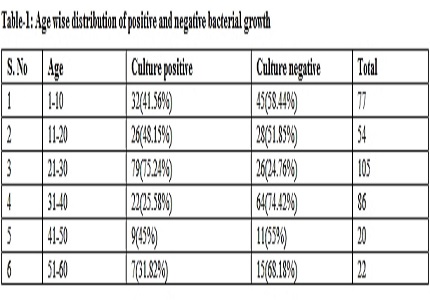Association between pyuria and uropathogen in suspected urinary tract infection
Abstract
Background: Urinary tract infections (UTI) are one of the most common infectious diseases diagnosed in outpatients as well as in hospitalized patients, and can lead to significant mortality. Several rapid methods have been developed in diagnosing urinary tract infections such as microscopic examination, chemical tests, and automated systems. Thus, in this study we aimed at determining pyuria in suspected UTI patients and their association with uropathogen.
Materials and Methods: A total of 379 clean catch mid-stream urine samples were collected in sterile containers. Manual microscopy is used to determine pyuria. All the urine samples inoculated on routine bacteriological media.
Results: Out of 379 urine samples, 181 yielded significant bacterial growth. Patients belonged to age group 21-30 were more commonly had significant growth followed by 11-20 years age group. Escherichia coli was the most common organism isolated. Majority of urine specimens which showed plenty of pus cells per high power field yielded significant growth. Escherichia coli was most commonly associated with pyuria.
Conclusion: As the number of pus cells in urine increases, the chance of yielding significant bacterial growth is also high. Overall, significant pyuria was observed among specimens yielded Gram negative bacilli than Gram positive cocci. Among Gram negative bacilli, Escherichia coli was most commonly accompanied with pyuria.
Downloads
References
2. Dash M, Padhi S, Mohanty I, Panda P, Parida B. Antimicrobial resistance in pathogens causing urinary tract infections in a rural community of Odisha, India. J Fam Community Med 2013;20(1):20-6.
3. Sood S, Gupta R. Antibiotic resistance pattern of community acquired uropathogens at a tertiary care hospital in Jaipur, Rajasthan. Indian J Community Med 2012;37(1):39-4.
4. Chedi, B.A.Z. Wannang, N.N, Halliru, M.A. Bichi, L.A., A seven months retrospective study of urinary tract infection among patients at Aminu kano teaching hospital, Kano- Nigeria, Bayero journal of pure and appliedsciences, 2009; 2(2): 95-98.
5. Wilson ML, Gaido L. Laboratory diagnosis of urinary tract infections in adult patients. Clin Infect Dis. 2004 Apr 15;38(8):1150-8. Epub 2004 Apr 6. [PubMed]
6. Jennifer L. Young and David E. Soper. Urinalysis and urinary tract infection: update for clinicians. Infect Dis Obstet Gynecol 2001;9(4):249–255.
7. Winkel P, Statland BE, Jorgensen K. Urine microscopy, an ill-defined method, examined by a multifactorial technique. Clin Chem. 1974 Apr;20(4):436-9.
8. Lorincz AE, Kelly DR, Dobbins GC, Cardone VS, Fuchs SA, Schilleci JL. Urinalysis: current status and prospects for the future. Ann Clin Lab Sci. 1999 Jul-Sep;29(3):169-75. [PubMed]
9. Mittendorf R, Williams MA, Kass EH. Prevention of preterm delivery and low birth weight associated with asymptomatic bacteriuria. Clin Infect Dis. 1992 Apr;14(4):927-32. [PubMed]
10. Colle JG, Miles RS, Watt B. Tests for identification of Bacteria. In Mackie and Mc Cartney’s Practical Medical Microbiology. 14th ed.Edinburgh: Churchill Livingston;1996. p. 146.
11. Anushree, C. N, Chandrakanth, Manjunath, Veena . Relationship between pyuria and bacteruria in suspected urinary tract infection Medica Innovatica.2014; 3( 2): p-84.
12. Kattel, H.P., S.K. Mishra, J.Acharya, A.S. Shah, B.P.Rijal and B.M.Pokharel. 2009. Relationship between pyuria and bacteriuria in suspected urinary tract infection.JNAMLS.2009;10(1): 19-21.
13. Dongol A, Joshi DM, Gautam A. Detection of Pyuria versus Bacteriuria in Suspected Patients of Urinary Tract Infection. Nepal Journal of Science and Technology. 2014; 15(1): 129-132.
14. Ginsburg CM, McCracken GH Jr. Urinary tract infections in young infants. Pediatrics. 1982 Apr;69(4):409-12. [PubMed]
15. Maskell. Study of urinary tract infections children in one health distrct. BMJ;1994 pp: 309.
16. Samia S. Khamees. Urinary Tract Infection: Causative Agents, the Relation Between Bacteriuria and Pyuria. World Appl. Sci. J.2012; 20 (5): 683-686.
17. Dhakal, B.K., B.M. Pokhrel and J. Ahnn. Microscopic detection of urinary tract infection in Nepalese patients. J. Microbiol.2002; 40(4): 267-273.
18. Hooberman A,Choa HP,Keller DM et al.Prevalence of urinary tract infection in febrile infants. j of pediatr. 1993;123(1):17-23. [PubMed]
19. Lam CN, Bremner AD, Maxwell JD, Murphy AV, Low WJ. Pyuria and bacteriuria. Arch Dis Child. 1967 Jun;42(223):275-80. [PubMed]
20. Hooker JB, Mold JW, Kumar S. Sterile pyuria in patients admitted to the hospital with infections outside of the urinary tract. J Am Board Fam Med 2014;27(1): 97-103.
1998 Jun;101(6):E1. [PubMed]
25. Mangiarotti P, Pizzini C, Fanos V. Antibiotic prophylaxis in children with relapsing urinary tract infections: review. J Chemother. 2000 Apr;12(2):115-23. [PubMed]
26. Kristiansen BE. [Pathogenic bacteria in the urinary tract. Incidence and resistance behavior]. Tidsskr Nor Laegeforen. 1983 Aug 30;103(24):1684-6. [PubMed]
27. Prais D, Strussberg R. Bacterial susceptibility to oral antibiotics in community acquired urinary tract infection. Arch Dis Child 2003; 88(3): 215-8.
28. Ladhani S, Gransden W. Increasing antibiotic resistance among urinary tract isolates. Arch Dis Child. 2003 May;88(5):444-5. [PubMed]
29. Shaikh N, Shope TR, Hoberman A, Vigliotti A, Kurs-Lasky M, Martin JM. Association Between Uropathogen and Pyuria. Pediatrics. 2016 Jul;138(1). pii: e20160087. doi: 10.1542/peds.2016-0087. Epub 2016 Jun 21. [PubMed]
30. Huang CT, Leu HS, Ko WC. Pyuria and funguria. Lancet. 1995 Aug 26;346(8974):582-3. [PubMed]
31. Quintiliani R, Cunha B, Klimek J, Maderazo EG. Bacteremia after manipulation of the urinary tract: the importance of pre-existing urinary tract disease and compromised host defences. Postgrad Med J. 1978;54(636):668-671.
32. Wakabayashi G, Gelfland JA, Jung WK, Connolly RJ, Burke JF, Dinarello CA.Staphylococcus epidermidis induces complement activation, tumor necrosis factor and interleukin-1, a shock-like state and tissue injury in rabbits without endotoxemia: comparison to Escherichia coli. J Clin Invest. 1991;87(6):1925-1935.
33. Virtanen S, Oksanen T, Peltonen T. Colony counts and the diagnosis of urinary tract infection in infants and children. Counts from clean-voided urine specimens and from those collected in plastic bags. Ann Paediatr Fenn. 1962;8:269-77.
34. Houston IB. Pus Cell And Bacterial Counts in The Diagnosis Of Urinary Tract Infections in Childhood. Arch Dis Child. 1963 Dec;38:600-5.



 OAI - Open Archives Initiative
OAI - Open Archives Initiative


